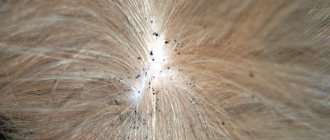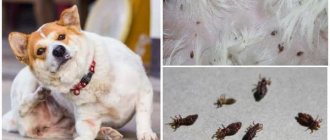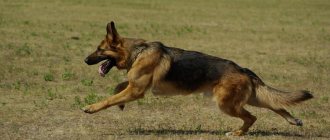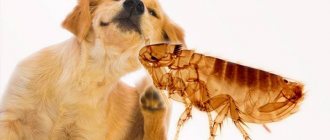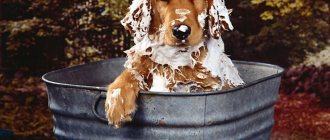An unpleasant situation arises when the owner of a recently purchased puppy or kitten discovers fleas on his little pet, especially if the parasites are in the litter.
Not all dog breeders know how to remove these bloodsuckers from a puppy, because for a one-month or two-month-old little dog the choice of suitable safe means is small.
The choice of method for combating small parasites in a small dog depends on where the kitten lives - indoors or outdoors.
In addition, in order to lean towards one method or another and decide on the choice of means against ectoparasites, it is necessary to take into account whether the baby is in the litter with its mother or has already been separated and lives with its owners.
You will learn what to do to rid your puppy of parasites in this article.
Where do fleas come from in puppies?
No dog is immune to these parasites, and there are many ways a puppy can pick them up. Moreover, the older the animal, the more variants of infection there are. Here are the main ones:
- In newborn puppies, infection from the mother is most likely;
- the puppy, which was handed over to new owners, could still have eggs or larvae of the parasite, which began to multiply and pester the baby more;
- it is quite possible that the first time your pet walks outside, a flea will cling to it;
- if other animals are found in the room with the dog, then there is a chance of infection from them;
- it is possible that the parasites could transfer to the baby from the owner’s clothes or shoes;
Due to these factors, it is necessary to closely monitor the puppy and other pets, periodically checking them for the presence of bloodsuckers, so that if insects are present, treatment can be started in the early stages.
How can you tell if your dog has fleas?
One of the main and most noticeable signs that an animal has fleas, which every owner should pay attention to, is severe itching of the skin (at the initial stage of infection it may be less pronounced). Typically the itching is localized on the neck, back and abdomen. The animal itches and begins to tear the skin, resulting in damage in the form of scratches, abrasions, irritations, and possibly the development of inflammatory processes.
It is quite difficult to see fleas, especially on dark dogs with thick fur. However, if you suspect that your dog has fleas, then you can do a simple test for flea feces in the animal's fur. To do this, take a comb-comb with dense teeth (you can buy a special anti-flea comb) and comb the dog’s fur. Fleas leave feces in a dog's fur and if the dog is infested with parasites, it will leave black spots on the comb.
The danger of fleas for puppies
For a young and unformed puppy, a flea bite is more dangerous than for an adult dog. Not only the severe itching, which bothers even older dogs, and even makes a small dog whine, but also a number of other reasons are dangerous for the baby.
- the young pet’s immune system is not yet fully formed, and they are completely defenseless against infectious agents that are transmitted by parasites through a bite;
- the puppy’s skin is still very tender and therefore will suffer more from allergic reactions to flea saliva;
- with severe infection, significant blood loss and anemia may occur;
- worms, which can be contracted from fleas, deplete the dog’s body;
If your pet often itches and bites itself, then you need to carefully examine it, and if parasites are found, immediately begin to remove them. Also, before mating, it would be better to treat the mother of the offspring with a long-acting agent so that she and the future offspring are protected during pregnancy and lactation.
Possible consequences of a flea bite
Even hints of the presence of parasites should not be ignored. One flea can also cause serious harm to a small pet:
frequent bites lead to the development of anemia in the puppy and subsequent exhaustion of the body;- constant itching causes stress;
- insect saliva provokes the development of allergic dermatitis;
- In areas of bites and skin damage, there is a high probability of viral infections entering through scratching.
Helminths also travel with fleas. They fall on the pet with insect excrement. When a dog licks fur, worm eggs migrate from the animal’s tongue to the esophagus and stomach, actively develop and harm the baby.
Symptoms and external signs
The first and main sign that your pet has fleas is its constant scratching. He can also chew his fur. And it is possible to find out whether the puppy was really attacked by parasites only through a detailed examination. You can comb against the grain to check for the presence or absence of bloodsuckers. They usually like to be located behind the ears, as this area has thinner skin and is easier to bite.
Fleas can also be detected during water procedures. Insects will jump off the pet or try to move to drier parts of the body.
Flea saliva causes very strong allergic reactions in babies, so redness will be another symptom. Sometimes it happens that due to the negative effects of parasites, hair loss may occur. Therefore, it is worth closely monitoring changes in the dog’s behavior and appearance.
Read Dog cough: types, causes, signs, treatment methods and prevention
Symptoms indicating a dog infection
In order to start treatment on time and get rid of the “infection” you have caught, you need to know how to understand that a dog has fleas. Regular inspection and combing of the animal's fur is your reliable assistant. Run a comb or hand against the fur; the white eggs of parasites are visible to the naked eye. You may also notice dark brown grains - this is insect waste.
When fleas have multiplied sufficiently on the animal's body, they become visible. Every dog breeder should know what fleas look like on a dog. These are agile brown insects that quickly hide in the undercoat. Parasites are afraid of water, so they can be easily seen while bathing a dog.
In addition to a visual examination of the pet, the presence of “bloodsuckers” is indicated by the following symptoms:
- The dog itches and does it continuously.
- The animal suddenly jumps up and tries to bite itself.
- Red spots of unknown etiology appear on the dog's skin.
- Bald patches, sores and scratches form on the dog's body.
- The animal whines pitifully for some unknown reason.
- The dog begins to shed prematurely.
- The pet becomes restless and irritable, loses appetite, and suffers from insomnia.
- A sharp decrease in the animal’s weight with proper feeding.
Since ectoparasites are carriers of other serious diseases, over time, gastrointestinal disorders, discoloration of mucous surfaces, and hyperthermia are added to the main symptoms.
As soon as an animal exhibits the above signs, it must be immediately taken to a veterinarian for an accurate diagnosis and treatment. Delay in this matter is unacceptable.
It will also be useful to read about worms in dogs and methods of treatment.
Features of treatment for puppies
When choosing a drug that will relieve the problem, you need to take into account the age of the baby. The younger he is, the less aggressive the components in the shampoo or drops should be, so as not to further damage or dry out the baby’s skin. In the first 6-8 weeks of his life, it is better to use simple methods of control; they will not be so effective, but safe for health.
To remove fleas from a puppy, it is important not only to use a special product, but also to clean the room at the same time. If there are other pets in the house, they should also be checked for insects.
Fleas on a 1 month old puppy
For a one-month-old puppy, even the most famous companies do not produce products to combat uninvited guests. You should not buy shampoo for older newborns; it is better to opt for traditional and mechanical methods:
- The first way is to bathe the puppy in a strong decoction of wormwood, tansy, wild rosemary or mint. Be sure to ensure that the drops do not get into the ears, nose and eyes. You need to keep your dog in this bath for at least 15 minutes. If all the offspring are infected, then bathe each puppy separately. After bathing and drying, the coat must be thoroughly combed over white paper or cloth to remove any fallen fleas;
- the second method is similar to the first, only using tar soap, which also has a pungent and repellent odor. First, wet the puppy with water and soap it generously, then freeze in a towel and a warm blanket so that he does not freeze, and hold this “mask” for at least 20 minutes. After this time, thoroughly rinse off the foam along with the dead fleas and do not forget about control combing , as in the previous paragraph;
Active ingredients such as herbs and tar will not harm the baby's skin and will not cause irritation or an allergic reaction, even if the puppy is only 2 weeks old. Therefore, they can be used for two-week-old babies and even newborns. But we must not forget about their mother - the main source of trouble.
Fleas on a 2 month old puppy
At this age, the feeding period has already ended and the offspring already have a more developed immune system, milk teeth and a strong physique. Therefore, it will be easier to exterminate fleas from such a puppy, since long-term preventive measures can be used.
- For this age, companies produce a large number of shampoos, but up to six months it is better to choose drugs with a minimum content of poisons, or better without them at all;
- Now you can buy collars designed for puppies and soaked in essential oils. But such a remedy will be ineffective if there are several puppies in the house due to the fact that they will chew each other’s collars and render them unusable;
- drops on the withers should be used based on the instructions and the age of the baby. Again, this method is suitable for a puppy living separately, since others may get poisoned;
- It is possible to use a spray that allows you to quickly and completely remove parasites, which are again allowed for this age. But, as with other products containing insecticides, they are contraindicated in litter.
Read Method of use and cost of Advantage for dogs
That is, if the baby is one of the animals in the house, then all these means are suitable. But if there are two or more of them, then you should be more careful when choosing a flea treatment method.
Fleas on a 3 month old puppy
For dogs of this age, most insecticidal preparations against parasites, which can be easily found in pet stores, are suitable. You can use shampoos and sprays without fear, but again you need to take into account your age. Collars will not be very effective because the puppy has already increased in size and, perhaps, the coat has become longer and thicker.
Treatment of puppies up to 1 month
Even renowned companies do not produce anti-bloodsucker medications for babies under 1 month old. Therefore, only mechanical methods can be used to combat insects:
- Wash the dog in a strong decoction of repellent herbs. Pour warm broth into a basin and immerse the puppy in it for 10-15 minutes. It is necessary to ensure that the liquid does not get into the baby’s eyes, ears and nose. Then dry the wool and comb it thoroughly over a white cloth. If the kids are all together, then you need to treat all the dogs one by one.
- Bath the crumbs in tar soap. Lather the dog and wrap it in a towel for 5-10 minutes. Then thoroughly rinse off the foam, dry and comb out the fur.
Tar soap for fleas - Use special shampoo for babies for the bath. Doctor Zoo shampoo can be used for pets older than 2 weeks. When choosing a shampoo, you should read the instructions, which should indicate at what age the baby can safely use the product.
- Frontline spray is recommended for use for babies from the first days of life. It can be used on pregnant and lactating dogs.
Important!
In order to effectively exterminate insects, you should act comprehensively. Before deciding how to remove fleas from a puppy at home, you need to thoroughly treat the dog's bedding, bed and the entire room. Flea treatments for puppies are chosen especially carefully.
The best flea remedies
There is a wide range of flea control products on the market. The main thing is to choose a product according to the puppy’s age and pay attention to its composition. You can rid your puppy of fleas with special shampoos, drops or sprays.
Shampoos
Zoo shampoos for puppies are made from natural ingredients with the addition of insecticides, which kill parasites. The shampoo is gentle on the skin, making it suitable for use on small pets. In just a few baths you can get rid of bloodsuckers, and as a bonus, this product takes care of the baby’s skin and coat. Such drugs are the safest, so there are more of them than drops and sprays. Here are some of them:
- Beaphar is a product from a Dutch company that includes permethrin and is suitable for dogs of any coat length;
- Phytoelite - consists of herbal extract and a small dose of permethrin;
- Celandine - contains essential oils and insecticide.
The shampoo is applied to damp hair, foams and lasts for about 5 minutes. Rinse off the foam well, rinse the wool and dry. As an addition, after this procedure you can comb your pet.
Drops
This drug is best used from the age of two months and if the pet is alone in the house. The product also contains insecticides, which are the active substance against parasites. It is applied to the puppy’s skin, spreading the fur, and to places inaccessible for licking. This procedure does not take much time and provides prevention against infection for a period of one to two months. The safest for puppies:
- Frontline spot - active substance - fipronil, recommended for use for pets over two months old, provided that its weight is more than 2 kg;
- Celandine drops - like shampoo, contain essential oils, but with the addition of fipronil;
There are other names of drops: “Bars Forte”, “Advocate”, “Practician”, which can be used to treat a puppy. Before use, be sure to read the composition and instructions.
Sprays and aerosols
They are good because they are easy to apply, work quickly and are highly effective. The spray kills fleas within a few minutes and protects against re-infestation. Before use, shake, apply to the entire body against the growth of the coat, slightly moisturize it. Processing must be carried out in a well-ventilated area or outdoors.
Read How to remove fleas from dogs: rating of the best remedies
It is better to choose certified sprays and aerosols that have passed quality and safety control. These include:
- Stronghold - contains selamectin, which destroys flea larvae, suitable for puppies over 1.5 months of age;
- Frontline - can be used even for the smallest ones, the number of presses on the spray can depends on the weight and length of the fur (a calculation table is included in the kit);
- Leopard - contains fipronil and protects the puppy for 30 days from all types of blood-sucking insects.
After application, do not allow your pet to lick itself and refrain from water treatments for the next 2 days.
Anti-flea collars
Typically used to prevent parasite infection. The collar is simply put on the pet’s neck and left for several months; it has a fairly long insecticidal effect. But if the puppy has sensitive skin, then it is quite possible that he will have an allergic reaction from wearing such an accessory. Typically suitable for animals over 10 weeks of age. Market leaders:
- HartZ - contains tetrachlorvinphos, which belongs to the third safety class, suitable for 1.5-2 months of age;
- Beaphar - has the same characteristics and active ingredient.
The collar will be effectively used in combination with another product, for example, shampoo.
Flea control rules - precautions
To quickly remove fleas, you must follow these rules:
- Act immediately. A distinctive feature of fleas is their rapid reproduction; if there are signs of infection, it is necessary to provide assistance on the same day. Also, the more parasites are present, the more difficult it is to get rid of them.
If you cannot recognize fleas on your own, it is better to consult a veterinarian to confirm the suspicion of parasite infestation. They can sometimes be easily confused with other canine problems, such as skin conditions.
- Choose the right product. Medicines sold in veterinary pharmacies are suitable for different breeds. To effectively cope with parasites, you need to choose a product that is suitable for the specific breed, coat type, and age of the pet. It is best to contact your veterinarian for a prescription.
- Follow the instructions. Most drugs in different dosage forms are indicated for use several times. If you use the product only once and neglect the next use, the parasites may return.
It is also important to observe safety precautions when using the chosen product. The tablets should be given to your pet according to the instructions. Shampoo and other products for application to the coat must be used strictly with gloves.
An infected pet must be isolated from other pets. If he lives at home, it is necessary to allocate a separate room for him, if on the street, do not let him out of the enclosure. You also need to protect your dog from contact with children, since fleas are carriers of many infections.
Traditional methods
They were mentioned a little earlier, as they are applicable for newborn babies. Traditional methods are based on the use of herbs. That is why they are so harmless for newly born puppies.
If the mother and offspring are in an enclosure or in a room separate from human habitation, then it would be good to place bunches of herbs such as wormwood, lavender, and bugs around the bed. They have a pungent odor that will repel nasty insects. For the convenience of animals, the bunches can be replaced with powder from the same plants. Herbs are safe even for babies, who may accidentally get the herb inside.
If animals live in the house, then the litter and the surrounding area should be treated with water with the addition of a couple of drops of essential oil of the same lavender, lemon, menthol or eucalyptus. This method also has a deodorizing and antimicrobial effect.
Do not forget about baths using herbs that have a pungent and repellent odor.
How to properly treat a room
Fleas live not only on animals, but also in the kennel, bedding, or even under baseboards in enclosed spaces, so in the fight against them it is very important to treat not only the pet, but also its usual habitat. The minimum action in this case will be vacuum treatment of the bedding and the animal’s habitual resting area, and to prevent parasites from entering the apartment from the entrance, you will have to additionally wipe the threshold, preferably using repellents
Among the main methods of disinsection treatment of premises, the following options are especially popular:
- Thermal impact. When the temperature outside is below zero, sometimes it’s enough just to take the dog’s bed outside for a few hours. The opposite effect would be boiling the litter or steaming it with an iron, which will also negatively affect fleas.
- Use of chemicals. The use of "Karbofos", "Phenaxin", "Reid" or other disinfectants with a similar mechanism of action is appropriate when disinfecting the floor, walls and corners of the room in which the animal is located. They are often used to disinfect upholstered furniture or large interior items, because the main thing is not to leave a single untreated item in the room, otherwise there is a possibility that repeated disinfection will be necessary.
- Traditional methods. From herbal and oily infusions or decoctions, to treat a room against fleas, all the same compounds can be used as when disinfesting the dog itself: wormwood, pine needles, laundry soap and kerosene. The latter is highly effective when used independently, while in all other cases it is advisable to combine traditional and chemical methods of flea control. In the simplest version, you can simply place sprigs of fresh wormwood under the baseboard and in the corners of the room, replacing them with a new part of the plant over the course of a month as they dry out.
- Professional pest control. This option involves the involvement of professional special services in the treatment of the premises, who are involved in eliminating not only fleas, but also other insects. In this case, the essence of the work is to use devices that provide the release of steam particles with the insecticide present in them, which, settling on the surfaces of objects, penetrate into their deep layers and infect insects hiding there. In comparison with previous methods of disinfestation, professional exposure is rightfully considered the most effective solution, but in most cases, people turn to specialists for help only in the most extreme cases.
Prevention
After a long fight against pests, you don’t want them to come back. Therefore, you should follow basic measures that will protect not only a small puppy, but also an adult dog from infection:
- avoid allowing the animal to come into contact with stray animals;
- regularly inspect your pet and periodically treat it with flea repellents;
- after getting rid of parasites, it is necessary to thoroughly vacuum the area and treat the surrounding area;
Fleas are not the worst thing that can happen to a pet; this phenomenon is quite common. The main thing is to notice this in time and begin effective treatment. It is necessary to carefully select the product; as you can see, they are quite varied and are not suitable for everyone. It is worth being patient and willing to help your pet, because no one except the owner will save him from endless itching and bites. Because we are responsible for those we have tamed.
Medicines for small breed dogs
This category contains medications that are intended exclusively for small breeds of dogs. These drugs have a small concentration of active substances, which helps to avoid negative consequences.
1
Novartis Prac-tik
894 rub.
We start our review of the best flea drops with Novartis Prac-tik. This drug is approved exclusively for small animals that weigh no more than 4.5 kg. In addition, there is an age restriction: this product is prohibited for puppies under 8 weeks of age. The active component of the drops is pyriprole, which has a pronounced acaricidal and insecticidal effect. With its help you can get rid of fleas, lice and ticks.
9.9 /10
rating
pros
- Affordable price
- No harmful components
- High efficiency
Minuses
Novartis Prac-tik
2
Advantix (Bayer)
RUB 2,618
These drops are the safest for pets. They are suitable for small breed dogs up to 7 weeks old. In this case, the dog’s weight should be between 4 and 10 kg. The drug has a contact-intestinal effect on pests. At the same time, it kills not only adult insects, but also the eggs they lay.
9.7 /10
rating
pros
- Safe composition
- Long validity period
- Suitable for prevention
Minuses
Advantix (Bayer)
3
Lawyer (Bayer)
RUB 1,381
Available in the form of drops, which are approved for use on dogs weighing up to 10 kg. This product is also suitable for puppies, but it can only be used after the pet reaches 7 months of age. The composition of the medicine is not too concentrated, so it is absolutely safe to use it to fight fleas. For the same reason, the drug is approved for pregnant dogs.
9.6 /10
rating
pros
- No harmful substances
- Suitable for puppies
- Easy to apply
Minuses
Lawyer (Bayer)
4
Frontline Combo S
620 rub.
This relatively inexpensive drug has become known for its long duration of action. It quickly kills fleas and protects your dog from their reappearance for 30 days. Combo S is suitable for puppies over 8 weeks old and adult pets whose weight does not exceed 10 kg. The medicine contains fipronil, which has a wide spectrum of action (kills fleas and their offspring).
9.4 /10
rating
pros
- Low price
- Long lasting effect
- Destroys flea eggs
Minuses
Frontline Combo S
How does infection occur?
Many dog owners are sure that their pet Tuzik, Rex or Polkan will definitely not catch fleas, since he does not leave the house and does not come into contact with stray relatives. However, even those pets who simply visit the toilet at home can become infected.
This happens for the following reasons:
- As a result of contact with sick animals . If a stray dog continuously itches, bites itself and literally bites into its fur, this indicates the presence of parasites. If a pet has come into contact with a suspected flea carrier, the pet should be thoroughly examined.
- After walking on the grass . Often, parasites literally fall from an infected animal, remaining in the grass. Climbing onto the highest blades of grass, they patiently wait for their next victim. And given the fact that fleas can jump 30 cm in height and 20 cm in length, it is not surprising that absolutely any animal passing by can become their victim.
- Through larvae . Baby fleas are no less dangerous than adult fleas. They can fall from an infected animal onto the grass, ground, or road. Eggs often end up in the house: a person brings them on the soles of his shoes or on his trousers.
The last point creates a risk of infection for pets that do not go outside. Thus, the danger of flea infection exists for all dogs, regardless of how often they are outside the home.
Even if the animal has been cured, the infection may recur, since insects and their larvae often remain on the dog’s personal belongings or attack furniture, carpet and other household items.
Preventive actions
To protect your home from fleas, you should follow simple requirements.
- Carry out frequent general cleaning - at least once a week, wash floors with disinfectant, vacuum carpets and upholstered furniture.
- Treat your pet for parasites in a timely manner.
- Wash outdoor shoes thoroughly.
It is enough to observe the usual hygiene requirements, which are the same at all times. But the main thing is to carefully monitor the animal, since in most cases it is the animal that can bring parasites into the house.
Rating of the best drugs
Today there are a large number of drugs that can be used to treat young dogs. However, despite all the diversity, it is quite difficult to remove parasites, so you need to know exactly which remedy is best.
All drugs are divided into several groups:
- shampoos;
- drops;
- sprays;
- solutions (for example, hellebore water);
- collars.
The undisputed leader among shampoos is Beaphar.
The undisputed leader among shampoos is Beaphar. This is confirmed by numerous certificates, as well as the great popularity of the company’s products. Animal shampoo has four levels of action:
- Fight against parasites.
- Preventing re-infection.
- Cleaning areas where an infected puppy has been.
- Deworming.
Shampoo is used once. It is important to avoid contact with the mucous membranes of the eyes, ears or tongue.
Drops are no less effective. This product is applied only to the neck area - where the dog cannot reach with its tongue and paws. This is necessary to prevent the pet from licking the poison. Babies can be given drips from the age of one month. The animal should not get wet for 24 hours after the procedure, so you should not bathe it or walk with it in the rain. To get the best effect, the animal can be treated several times.
Shampoo is used once. It is important to avoid contact with the mucous membranes of the eyes, ears or tongue.
The third option is a special collar for your pet. It is used for the prevention of infection rather than for treatment. You can be sure that there are no fleas if you constantly follow preventive measures. The collar can be used at any age, which is especially suitable for small pets.
The choice of other options is large - drops, solutions, and shampoos. What is the best flea treatment for puppies? The question is controversial. It is advisable to use several options.
User reviews
Marta, 32 years old: “I was advised to use a collar for my Marsik as a preventive measure. However, for a long time I wondered: “When can I put a flea collar on a small puppy?” The internal struggle in me was resolved by a pharmacist who also has a pet. I’ll be honest, I changed collars several times over the course of a year, but I never regretted my choice.”
Oksana, 28 years old: “With the advent of the little Rottweiler, I was interested in only one question: “Can one-month-old puppies be treated for fleas?” And if so, then with what. I chose the best option - Beaphar shampoo. To be more reliable, I used it twice, and now there are no insects on our baby.”
